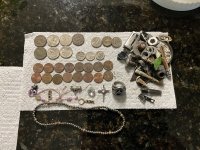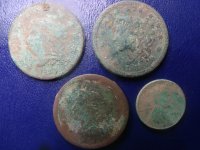S
sportfisher411
Guest
This question is to all, Is there a particular way in which your coins are situated when you find them? ie. horizontal, verticle or at another degree of rotation. Im just interested to see if the sink rate for a verticle coin is faster than a horizontal coin. Just think if they do sink faster then there are alot of deep, nice finds to be had.
Amazon Forum Fav 👍
Upvote
0





 Anyway, Freezing & thawing Absolutely moves things around. Fill a glass to the brim, & stick it in the freezer. The ICE will rise above the rim. in the ground If there is a coin at just under the soil. the top of the ground will freeze & push. as the ground under the coin freezes it will also push. This is why up here, you may miss a target one year , but in the spring find it. as The Pushing & shifting will move a Coin from maby this Position? ( l ) in the ground to? ?( / ) this position , and eventually ( _ ) this.? ?Test what I'm saying, take a plastic Bingo or Poker Chip. , fill a glass to the brim, float the chip & freeze. see what angle the chip is frozen in the ice. now realize ground is thicker then water & when the ice thaws . the chip would stay in that position if not in liquid.?
Anyway, Freezing & thawing Absolutely moves things around. Fill a glass to the brim, & stick it in the freezer. The ICE will rise above the rim. in the ground If there is a coin at just under the soil. the top of the ground will freeze & push. as the ground under the coin freezes it will also push. This is why up here, you may miss a target one year , but in the spring find it. as The Pushing & shifting will move a Coin from maby this Position? ( l ) in the ground to? ?( / ) this position , and eventually ( _ ) this.? ?Test what I'm saying, take a plastic Bingo or Poker Chip. , fill a glass to the brim, float the chip & freeze. see what angle the chip is frozen in the ice. now realize ground is thicker then water & when the ice thaws . the chip would stay in that position if not in liquid.?  ? now imagine this process going on over 1 or 200 years ; ?Jeff
? now imagine this process going on over 1 or 200 years ; ?Jeff



